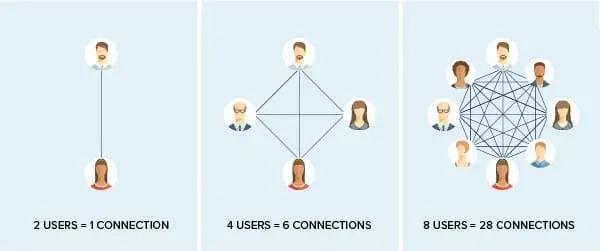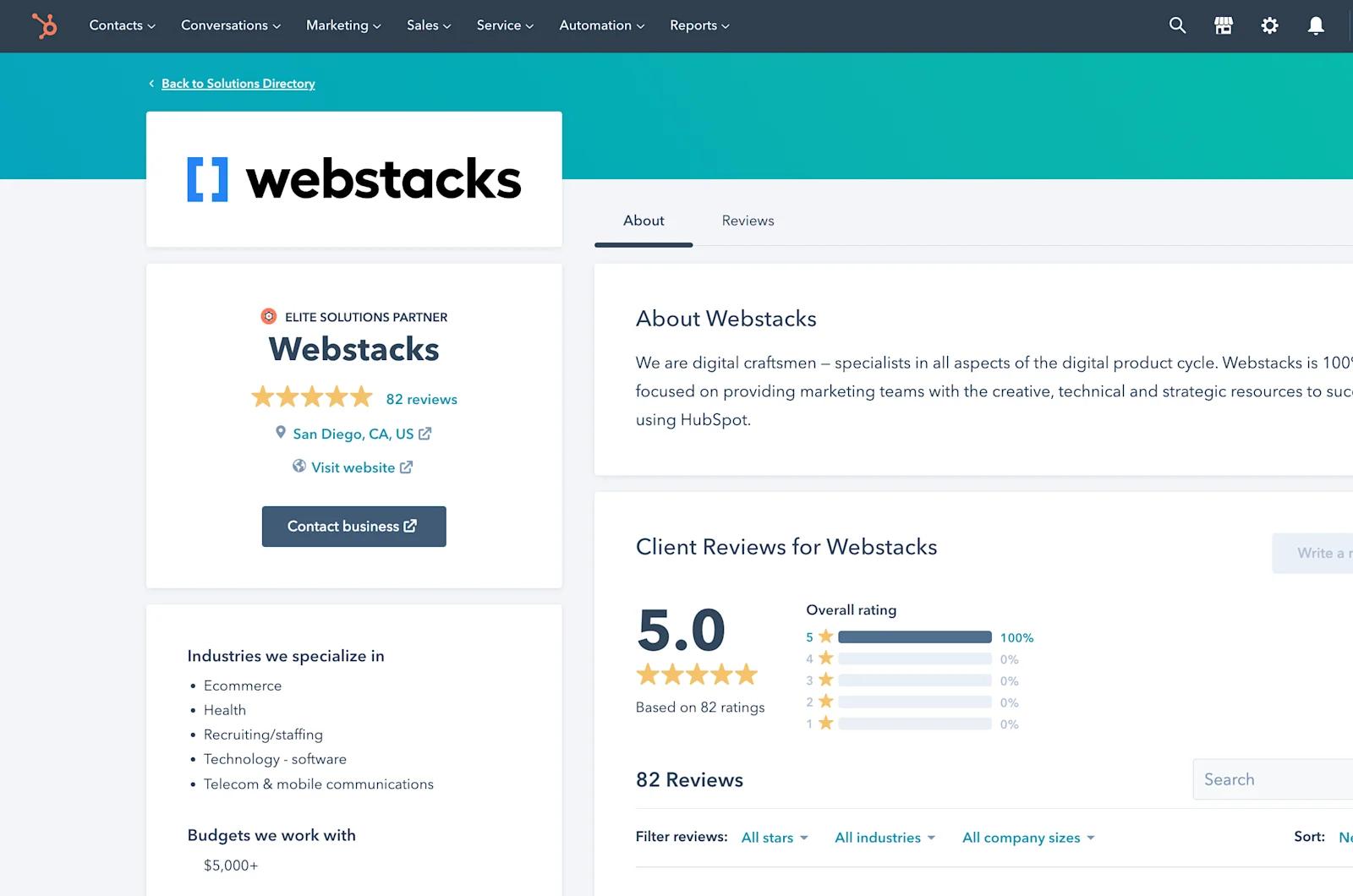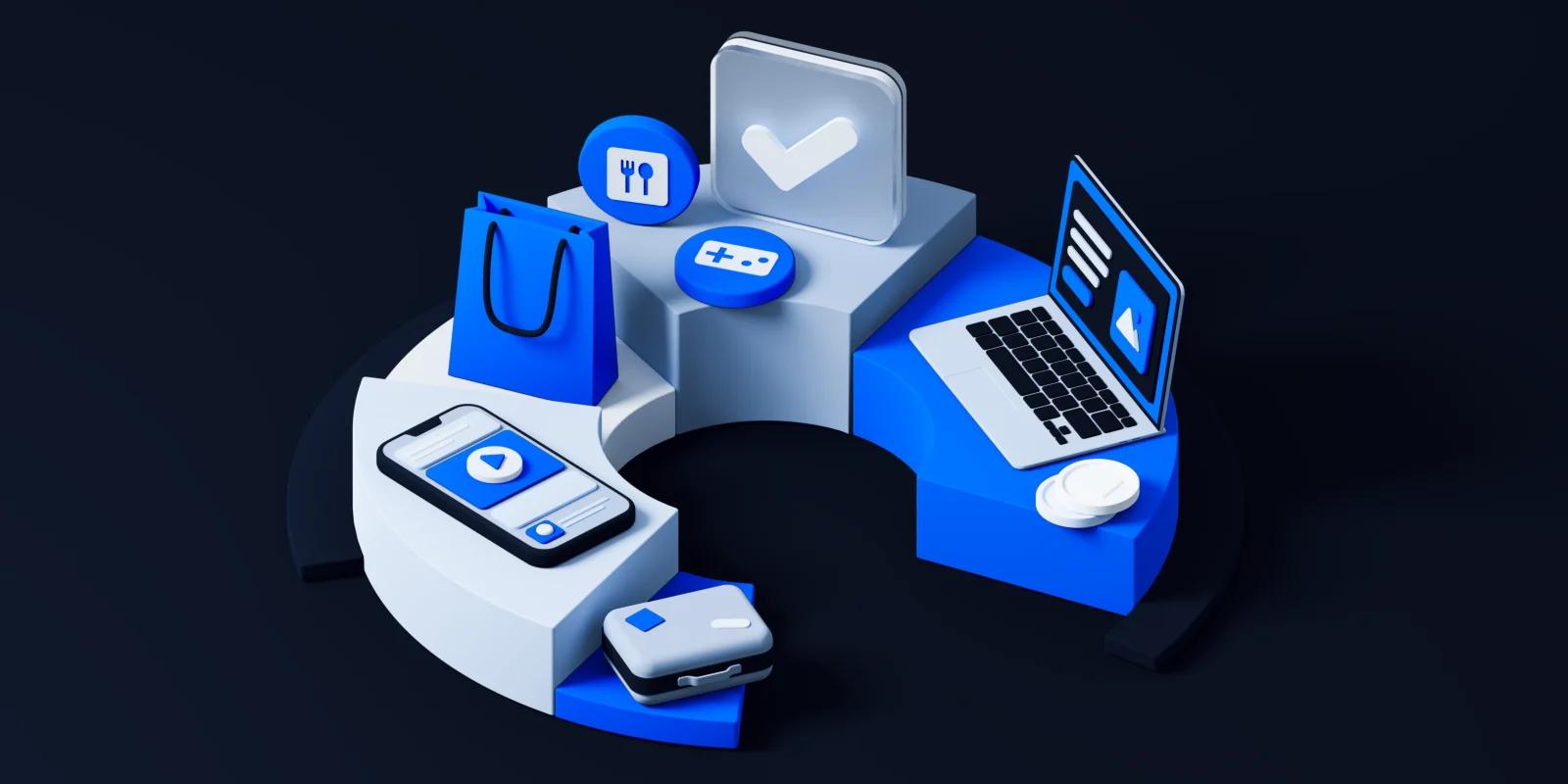Partner Networks Bring Opportunity
Partner networks are composed of industry disruptors that share the same goals, have similar software, have mutual business relationships, or all of the above.
Many leading companies have attributed the majority of their company growth to the power of network effects.
In this article, we will explain the concept of network effects and why SaaS leaders should consider taking on a new opportunity and building out their partner program to increase their network with one model.
You will also learn how some of the top pattern programs in SaaS have managed to increase their revenue, establish an indirect sales channel, enhance their product portfolio, and extend the reach of their network.
Explaining Network Effects with Metcalfe’s Law
Network effects are summarized best by Metcalfe's law, which states that a network’s value is proportional to the square of the number of nodes in the network. Each person or thing within a network represents a single node of the network.

network-effect-2
For example, a network with five nodes has a value of 25 (5x5), but a network with ten nodes has a value of 100 (10x10). By doubling the size of the network, the network's value has quadrupled.
Like in partner networks, when a new organization -- a new node -- joins the network, the value of the network increases for all parties.
That said, there are two types of effects: direct and indirect.
Direct effects happen when an increase in nodes directly increases the utility for all users in the network.
Indirect effects happen when users of one type (customers) join a platform or network to create value for users of another party (vendors).
When quadrupled, network effects are driving forces for the success of partner networks.
The 3 Main Participants in a Partner Network
Why does this concept matter?
Leaders are always looking for the next best opportunity to grow their business.
In the technology industry, leaders like yourself are always looking for ways to build relationships with agencies, solutions partners, and customers to improve and drive business relationships.
In SaaS, partner networks (or programs) are a business strategy that drives reach for vendors and partners involved while keeping customer pain points top of mind.
Successful partner networks all have one thing in common: They ensure all three stakeholders (vendor, partner company, and customer) win.
- Vendor - Attracts, retains, and boosts loyalty among customers by offering the right solutions in an integrated manner.
- Partner company - Gains access to the platform’s users and expands its business with additional customers.
- Customers - Find innovative solutions that address business needs - because of the partnership.
A SaaS vendor is an organization with a product or software aimed to resolve a specific pain point. They’re like any other business.
A partner company can join a vendor’s network as a solutions agency, a reseller partner, or a referral partner. The key here is that the partner company shows enough faith in the vendor’s product that they’re willing to offer it as a solution or add-on to their services.
As stated in Metcalfe’s Law, the network grows.
Partner Programs are Similar to Social Networks
Perhaps you’re more familiar with how social networks work.
Social networks are prime examples of network effects because users on any social platform can find both direct and indirect value from joining a group based on interests.
Partner networks work the same way but instead, partner companies and their customers join vendor networks based on their needs.
To continue our example, when partner companies join a vendor’s network as one of the three types of partners (solutions, reseller, or referral), they introduce the vendor to a new set of customers.
An example of the network’s reach increasing.
If you recall, this network started with one node (the vendor) before adding multiple nodes (partner company and its customers). Let’s say the partner company has three loyal customers.
If you double the vendor’s network, the program increases to two partner companies and six customers.
The diagram below shows how both vendors and partners equally benefit from more people joining a partner network:

Indirect-direct-effects-table
As the vendor’s network gains trust, the ecosystem grows through direct and indirect effects.
How Metcalfe’s Law Drives HubSpot’s Partner Network
SaaS partner networks are the type of communication networks described in Metcalfe’s Law whose value increases as they grow exponentially in size.
HubSpot’s partner program is a great example. One of the main incentives that HubSpot offers its partners is the vast array of technical integrations.
With over 500+ integrations, partners can choose the software that best integrates with their tech stack and expand their technical knowledge of the HubSpot platform.
With this technical exposure, partners can help their customers drive their marketing, sales, and customer success strategies using HubSpot software.

Webstacks-hubspot-partner-directory
As a result, partners form a global ecosystem of service providers ready to help new customers use HubSpot. This roster of partners includes organizations like Webstacks, Remotish, and Revenue River.
As head of the partner program, not only does HubSpot help agencies and service providers grow their business and the technical knowledge of their customers, but they extend their service offerings through network effects.
HubSpot has the services, partners learn how to implement them, and partners sell or recommend HubSpot services to their customers.
How Network Effects Drive Revenue
Partner programs are common in SaaS for two reasons:
- For partner companies and vendors looking to leverage partnerships with leading brands.
- To offer innovative solutions to customers.
When vendors add partner companies to their program, they’re extending their reach by way of indirect effects.
Let’s look at HubSpot again.
HubSpot generates 40% of its revenue from its B2B SaaS partner program. But it’s important to note that partner programs are more than a money-making stream.
It’s important to note that HubSpot isn’t selling directly to the customers that indirectly join their network by partner companies. HubSpot creates another indirect sale channel when its partners sell or refer HubSpot solutions to their customers.
IBM is another example of a partner network with over 150,000 partners, stating that 20% of its sales are generated from partners alone.
Network Effects Increase Unbounce Trial Sign-ups
In addition to increasing sales, organizations can leverage network effects to amplify growth and grow their network reach.
Let’s take a look at Unbounce.
Labeled a startup by PartnerStack, their no-code platform is perfect for building campaign landing pages without code.
Unbounce realized how successful they were at converting trial users into loyal subscribers after trying the platform for the first time.
Trial sign-ups are the most important KPI for the Unbounce team, convincing them to capitalize on the opportunity to extend their product reach and provide value for more organizations and single users through no-code web page building.
Unbounce saw the opportunity to create an indirect sales channel by building a partner network that offers 20% recurring revenue for every referral by a partner.
Partner companies who are either solutions agencies or SaaS companies using Unbounce now have an incentive to join Unbounce and refer to their software as one of their core services.
As explained by Metcalfe’s Law, new customers indirectly benefit from the Unbounce product, and partner companies benefit directly from Unbounce’s partner network through referral revenue.
As a result of the partner network, Unbounce accredits 25% of revenue from partner referrals and now has a partner ecosystem of 5,000+ partners.
The Unbounce team found an opportunity to increase revenue and spread their value and mission of building pages with no code to thousands of organizations and people looking for a page-building solution.
All Unbounce needed to build their partner network: Metcalfe’s Law and paying customers.
Shopify and Slack Create New Opportunities and Enhance their Product Portfolio through Network Effects
To continue the narrative found in SaaS by way of examples, Shopify and Slack are popular software companies spearheading some of the most robust partner ecosystems.
Though different, these high-profile SaaS companies both leverage network effects to create a wide array of opportunities as product and service providers.
Shopify’s partner network is a referral program that offers partners a 20% commission on any referred customer’s subscription fees.
The goal: To get more Shopify agencies who are masters in E-commerce to join their network and spread the word on Shopify’s e-commerce platform.
But what’s even more remarkable is that Shopify gives partners their ecosystem to cross-sell and offer their native solutions because these partner companies aren’t all about selling Shopify.
You’ll even notice that many partner companies have a dedicated partner page sharing what prospects will get by onboarding with a partner, plus other service offerings such as implementing custom 3rd party integrations, new CRM software, reporting analytics dashboards, and more.
On the contrary, Slack’s partner network is a technical program that helps other partners share information or integrate technology to improve their product portfolio.
Slack’s strategic partnership with Google allows Slack to expand its offering to enterprise customers and offer its customers a suite of integrations.
Startups interested in enterprise solutions can integrate with Slack, securing an efficient communication tool with several integrations. Slack’s partner program is an example of an indirect network effect that provides value to enterprise users who join Google.
On one end, you have a partner ecosystem like Shopify’s, allowing partners to cross-sell by using their service offerings to create more value for the paying customer interested in the e-commerce platform. Everyone wins.
On the other end, the Slack partner ecosystem serves providers like Google with answers they otherwise cannot find without the help of Slacks software. Their ultimate goal is to work together to improve their solutions for their customers. Everyone wins, again.
Why Customers Should Remain the Focal Point
Customers will always be the thing vendors use to measure the success of their partner program.
Partner offerings from a vendor to partner companies must create value for customers, whether they’re companies from the food industry, blockchain companies, financial service institutions, or others.
Salesforce Research showed that 63% of consumers expect businesses to know their unique needs and expectations, while 76% of B2B buyers expect the same.
No matter who the customer is, the value must be equitable and present.
A successful strategic partnership also requires a high level of trust by both parties. Being a great partner means working collaboratively to bring the customer success.
Get your Partner Network Up and Running
Understanding Metcalfe’s Law is the key to building a successful partner network and spreading your business value across nodes. If you have SaaS partners already, then you won’t need to look too far for partner companies.
But it’s important to keep in mind that the customers will always come first. Vendors and partners who work closely together and understand this concept will deliver and achieve outstanding results.




